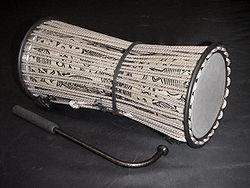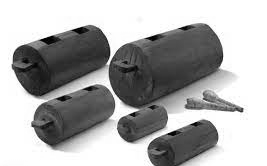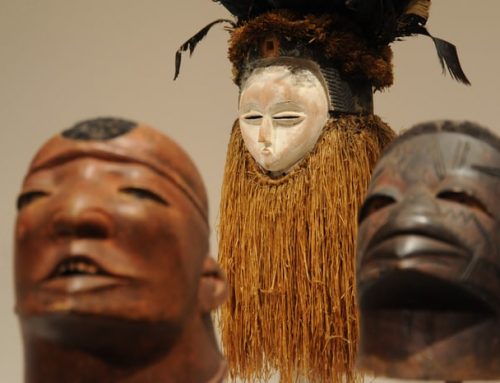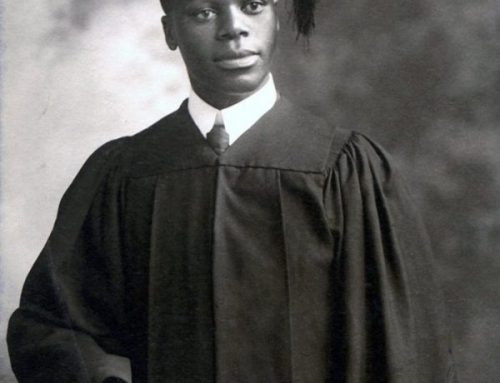
Music is an essential part of the lives of Africans. Music serves as a medium of communication between them. Africans use music for healing, entertainment, and to pass messages to each other.
In ancient African history, priests could communicate with their families with music produced by beating a particular type of gong against each other. This gong produces a particular type of musical sound that can only be heard by the priest’s family members.
Music is also used to tell stories (Folktales) in Africa. Music also serves religious purposes. You can tell what religious activity is being carried out by what music is being played. Africans not only sing a variety of songs, they also make music with musical instruments.
Musical instruments serve as a means of communication, entertainment, and festivity to Africans.
These instruments can be used for variety of things which serve different purposes. For example, the musical instruments used by Africans are crafted mainly by them; they use their skills to make instruments out of several materials like wood, brass, raffia, leather, rattles, iron, and bells.
These instruments span centuries and years in history, and today they are still played in communities, villages, cities, and every part of the world.
Today, in history, African music and musical instruments are now becoming influential. Africans are now getting recognized for their involvement in music and how their invented musical instruments have transformed the music world.
Some of these popular African musical instruments are:
-
MBIRA

Mbira is a type of musical instrument which originates from the Shona people of Zimbabwe. It is usually made by attaching prong-like metals to a flat wooden surface.
This instrument is played by plucking the prong-like metals with the right and left forefinger while occasionally using the thumb. The Mbira is usually played at wedding ceremonies, religious or social gatherings. However, it can also be found among the people of Malawi.
Mbira can be called other names like:, Sansa, Mbla, Ikembe, Likimba, Kalimba, Sanza, Marimbula, and Sansu.
It makes a chime-like and percussive sound when it is played.
There are various types of Mbira; Mbira dzavadzimu Mbira Nyunga Nyunga, Njari mbira; with differences in their sounds and keys.
The Mbira has since been discovered in some parts of Mozambique, Zambia, and the Zambezi River.
-
TALKING DRUM

The Talking Drum is a common instrument used in most parts of West Africa. It is used by several people for several purposes.
It is usually used to mimic spoken languages. It has an hourglass shape with two drum heads connected to each other. The history of the talking drum can be traced back to the Yoruba, Bono, and Ghanaians.
It is made with different materials and comes in various shapes and sizes. Some are placed on the ground to be played depending on the size, while some are placed under the armpit and beaten with a carved wooden stick.
Drums can be made of gourds and shells, but the talking drum is usually made of wood.
Drums serve various purposes for Africans: It can be as simple as a Group of people beating the drum for a group of dancers in a place. It can also be beaten to announce the death of a prominent member of the society like a chief or king.
The Talking Drum is also used to announce the entry of a king in the palace or to pass a message to the community about a meeting, or to issue a warning. They are also used to announce the death of the king.
Drums vary in size and sounds. Some drums can only be heard where it is been beaten, while some can be heard from a very far distance.
The history of the talking drum cannot be complete without the story of the deity drummer ‘Ayangalu’, who was said to have been the first drummer among the Yoruba people of Nigeria. He was said to have the power to inspire drummers to play well, and today, we still hear of Yoruba families whose name contains the prefix ‘Ayan’ who are believed to be descendants of Ayangalu.
The Talking drum is a popular type of drum that has been used over the years in popular songs. It is also used in playing Fuji music, Juju music and used for entertainment in weddings and funeral events.
-
SHEKERE

The Shekere is a musical instrument made of gourd-shaped wood. It is adorned with colorful, plain beads and anything that makes a rattling sound. The beads are netted around the gourd with strings or thin ropes. The Shekere is notable for its shaking sound when the bead is beaten against the gourd by shaking the gourd or pulling the netted beads against the gourd.
Shekere has made an influence on music through its shaky and rattling sound.
It originates from West Africa and can be found in countries like Nigeria, Togo, Ghana, Cote d’Ivoire, Benin, Sierra Leone, etc.
The gourds used in making Shekere are usually very strong yet lightweight. It comes in different shapes, sizes, and styles.
Shekere among the Yoruba people in Nigeria is used in promoting their traditional music and religion. It can also serve as a form of respect.
In Ghana and Togo, the Sekere is called ‘Axatse.’ In Sierra Leone, it is called ‘Shaburay.’
-
DJEMBE

Djembe is a goblet-shaped drum common among the people of West Africa. There is a saying by the Bambara people of Mali, ‘ Anke dje, anke be’, which means ‘Everyone gather together in peace.’ This elucidates the purpose of the Djembe.
Over the years, Djembe has been transformed from the standard rope-covered drum to a better quality, and excellent sounding mahogany carved drums.
When it is ensembled, the rhythm it creates makes the people gathered around it dance, clap, and sing to the beautiful rhythm it makes.
-
BALAFON

Balafon is an African Xylophone whose name was coined from the combination of Bala (a name given by the Mandikans) and Fon (meaning ‘to speak’). It is a prevalent instrument among West Africans. It was developed in the 12th century during the rise of the Mali Empire and was used to entertain crowds throughout history.
It consists of bamboo frames and wooden keys (the wooden keys used for the first set of Balafon were majorly Rosewood, but as time went on, it became hard to get Rosewood, so other types of hardwoods were used instead).
It takes a skilled Balafon player to play the African Xylophone. It can also be called a Gourd-resonated Xylophone.
The Balafon is played in several parts of Africa, namely; Gambia, Guinea, Mali, Ghana, etc.
-
KORA

The Kora is a long-necked stringed instrument whose origin stems from West Africa. It was first discovered in the Gambia, and since then, it has been played in Guinea, Mali, Burkina Faso, and Senegal.
It usually comprises 21 strings which are passed through a Gourd Resonator. It is made from cutting a big calabash gourd into two and joining a long hardwood to the gourd with cow skin. This hardwood serves as the neck, and then two wooden handles are used to hold the skin in place.
It is played by plucking the strings of the Kora with the fingers.
The Kora makes a melodious sound like that of an Harp or sometimes a Guitar, depending on how it is played.
Kora Music has also been used to communicate the need for peace and unity in some African countries.
-
EKWE

Ekwe is a traditional instrument made by the Igbo people of Nigeria. It is carved out of a wood or tree trunk. It also comes in various sizes and designs.
It is a type of drum carved rectangularly with slits in the interior. It is played with a wooden stick or mallet.
It is mainly used during the Igbo cultural events or for entertainment during marriage or funeral ceremonies. In addition, it can be used for celebrations or to announce an emergency.
Ekwe can also be found in Cameroon.
-
UDU

The Udu is a musical instrument played by the Igbo women of Nigeria for ceremonial purposes. It is made of clay, ceramics, and metals and molded in the shape of water jugs and pots with holes on the sides.
The women play the udu by hitting the big hole on the udu with their hands, producing a brass sound. The sound can be changed by repositioning the hand above the upper hole.
The Udu is widely played by Percussionists in Ghana and some other parts of the world today.
-
NGOMBI

Ngombi is traditional instrument that can be found among the Fang/Kele people of Gabon or Equatorial Guinea in the central parts of Africa.
It dates back to the 19th century and can also be called the Arched Harp because It is triangularly shaped like an Arched Harp. It is made by attaching strings to a leather or snake skin-made soundbox and carved wooden neck fitted with tuning pegs.
It is classified as a Chordophone-Harp musical instrument.
Sculptors carved faces on the harp to depict images of dead people and spirits. It is sometimes used to portray. When the images are whitened with Kaolin, they use this to express the sacredness of the harp.
Ngombi is played mostly by men in ceremonies, rituals, and other forms of entertainment.
Some religious organizations, such as the Bwiti in Gabon, used the Ngombi to foster communication between the living and the dead.
-
ALGAITA

The Algaita is a trumpet-shaped bell common among the Hausa and Kanuri people in the northern parts of Nigeria, West Africa. It dates back to the 20th century where the Hausa people carved wood, metals, and leathers to make sonorous sounds which brings calm to the atmosphere.
It is a double-reed wind instrument constructed like a trumpet; it has open holes in which the fingers are placed when played. This distinguishes it from the trumpet, in which keys are carved instead of holes.
The Algaita is a special instrument used only in the presence of Governors. Nevertheless, it has been used throughout the world by musicians.
The parts Africans play in the history of music have always been disregarded. Apart from drums, whose origination is usually associated with Africans, there has always been a belief that Africans do not have other musical instruments.
To Africans, musical instruments are not only for making music, but it is also a part of the culture, religion, and beliefs.
Some carvings in the instruments are symbolic and significant to a particular culture or tradition.
Unlike other continents, sometimes there are rules and guidelines associated with each instrument. For example, some instruments can only be played by women or men. Some instruments can only be played on a particular occasion. Some instrument signifies an evil omen or bad news. Some instruments are used primarily for celebrations. Some instruments are used only by people of royalty, while some are used only by a set-apart family.
Below is a list of musical instruments that were usually said to have been from other parts of the world but are actually from Africa:
- Akoting
- Marimba
- Maracas
- Sistrum
- Gong
- Water Drums
- Thumb Piano
- Bells and Metal Doube Bells
- Rattles
- Harps
- Musical Bow
- Elephant Tusk Trumpet
- Royal Trumpet
- Atumpan
Hanno the Carthaginian, who recorded a brief visit to the west coast of Africa in the 5th century BCE during a naval expedition, noted wind instruments as well as percussion. Of an island within the gulf of “Hesperon Keras,” he wrote:
“By day we saw nothing but woods, but by night we saw many fires burning, and heard the sound of flutes and cymbals, and the beating of drums, and an immense shouting. Fear therefore seized on us, and the soothsayers bid us quit the island.”
African music continues to thrive as music has now expanded from what it used to be Jùjú, Fuji, Makossa, Highlife, Kizomba, Afrobeat to new and improved music genres like Blues, Jazz, Hip Hop, etc.
Today, African music is loved and heard all over the world.
Reference: African Music – Musical Instruments | Britannica.
https://www.britannica.com/art/African-music/Musical-instruments




Awesome.
Thank you Jack!
great
Why is it I always really feel like you do?
Hello,
We provide funding through our venture capital company to both start-up
and existing companies either looking for funding for expansion or to
accelerate growth in their company.
We have a structured joint venture investment plan in which we are
interested in an annual return on investment not more than 10% ROI.
We are also currently structuring a convertible debt and loan financing
of 3% interest repayable annually with no early repayment penalties.
If you have a business plan or executive summary, I can review to
understand a much better idea of your business and what you are looking
to do, this will assist in determining the best possible investment
structure we can pursue and discuss more extensively.
If you are interested in any of the above, kindly respond to us via this
email. waheedalgore@alarisinvestmentgroup.org
Gmail: waheedalgore22@gmail.com
Sincerely
Waheed Algore
Head of Finance
Al Aris Investment Group
We are a Team of IT Experts specialized in the production of authentic Documents and Counterfeit bank notes. We work with government officials, professors and professional hackers from China, US, Russia, Taiwan etc. All these documents are registered into the supposed database. Documents such as Passport, Visa’s, Driving License, Covid19 Vaccine Card, University Certificates etc. We also have Canadian dollars, US dollars, pounds and euros. We also have our money in categories, Grade A quality that works at ATMs and bypasses the fake money detector and we also have the normal stage money that was used in jokes, commercials, music and movie videos. Contact details below.
WhatsApp….. +44 7459 530545
Email Address…. jameskinds65@gmail.com
Telegram ID….. “@Jameskind65”
Wickr Me ID….. Jameskind65.
Good afternoon!
I really like your forum.
master Brian.
P.S. Ta! for staying on a-one of the entirety and keeping things in motion
Hello,
We provide funding through our venture capital company to both start-up and existing companies either looking for funding for expansion or to accelerate growth in their company. We have a structured joint venture investment plan in which we are interested in an annual return on investment not more than 10% ROI. We are also currently structuring a convertible debt and loan financing of 3% interest repayable annually with no early repayment penalties. If you have a business plan or executive summary, I can review to
understand a much better idea of your business and what you are looking to do, this will assist in determining the best possible investment structure we can pursue and discuss more extensively. If you are interested in any of the above, kindly respond to us via this email. waheed@almarisinvestmentgroup.com
Waheedalgore22@gmail.com
Sincerely
Engineer Waheed Mohammed
Chief Financial Officer
Al-Maris Investment Group
best ringtones https://ringtonessbase.com
car sounds https://sounddeffects.com/car-sounds
animal ringtones https://downloadfreeringtoness.com/animal-ringtones
Hello,
Happy New Year ,
I am the Auditing Director in the Bank of Ghana which is the Apex Bank of Ghana; I direct the auditing of accounting and financial data of various departments within the Bank of Ghana. During the Bank independent examination of financial information, I found out about this dormant account containing a contract balance fund $8.9 Million Dollars, The funds $8.9 Million dollars belongs to Late American Contractor Late Timothy Truax , he executed LNG pipeline contract for Ghana Petroleum commission , i will Tell you how the funds will be transferred to your bank account legitimately immediately i receive your response indicating your readiness to receive the funds and i want 50% of the funds after it is transferred to your bank account nominated by you.
Reply to private email address : jamesosei@gmx.com
Warm Regards
James Osei
Review of Online Schools in Illinois, explore / all the advantages.
Best Online Schools in Illinois, develop.
Best Online Schools for Kids in Illinois, useful information.
How to choose the ideal online school, for studying in Illinois, key points.
Why choose an Online School in Illinois, for all students.
How Virtual classrooms work in Illinois, at your fingertips.
Why choose an online school in Illinois?, in modern times.
Online Education: Online schools in Illinois, for career growth.
How is learning going in online schools in Illinois?, interactive lessons.
How to choose the Best Online School in Illinois, to make an informed choice.
Parents ‘ Reviews of online schools in Illinois, important to know.
Online School Programs in Illinois, in all subjects.
Tips for improving academic performance in online schools, for students.
Online courses as part of the Illinois Curriculum, pros and cons.
How to Choose an Online School for High School Students in Illinois, prospects.
Answers to questions about distance education / FAQ on online schools in Illinois, for anyone interested.
Online Education Trends in Illinois, has to offer.
Online Adult Education in Illinois, for a new start.
Prospects for online schools in Illinois, and the education system / in the light of new technologies.
Online Schools in Illinois [url=https://neools-illin.com/]Online Schools in Illinois[/url] .
Online Learning in Maryland, for students.
Top-level online tuition in Maryland, learn about benefits.
Online education in Maryland, accessible to everyone.
How do I choose an online school in Maryland?, for a comfortable learning process.
Review of popular online schools in Maryland, with reviews and ratings.
We understand online learning in Maryland, how to make the right choice.
Tips for Online Learning in Maryland, for students.
What is the difference between online schools in Maryland?, have information before choosing.
Why choose an online school in Maryland?, find out all the advantages.
Student Reviews of Online Schools in Maryland, what is important to consider.
Courses in online schools in Maryland, for successful learning.
What to Expect from Online Schools in Maryland, consider.
Tuition rates for Online schools in Maryland, for budget planning.
Review of online school programs in Maryland, tailored to individual needs.
What are the latest developments in online education in Maryland?, find out the latest news.
How to succeed in Online Education, that will help you.
What hinders successful learning in Maryland’s online schools?, what you need to know.
Maryland Online Schools: The Complete Guide, to choose the best path.
What’s in store for online education in Maryland?, what will be important in the future.
Traditional Education vs Online: What should I choose?, for achieving your goals.
Online Schools in Maryland [url=http://www.nehools-mary.com]http://www.nehools-mary.com[/url] .
Find the perfect online school in New York City, online education.
What do you need to know about online schools in New York?, learn secrets.
Comparison of online schools in New York, rate.
Get an online education in New York City, your path.
The future of online learning in New York, with the latest updates.
Best practices for choosing an online school in New York, for parents.
Virtual classes in New York: what you need to know, for everyone.
Get an education in any environment with online schools in New York, develop professionally.
How are online schools changing education in New York?, innovations.
Top online schools in New York by price and quality, choose favorable offers.
How do I organize the learning process in an online school?, your guide.
What do New York City’s online schools offer?, learn / the nuances.
High-quality education in New York, how to make the right choice.
How do I protect my data in online education?, take care of yourself.
How online learning has changed people’s lives, learn more.
What has changed in online education since 2020?, master.
Secrets of successful learning in New York City’s Online Schools, use.
Online Schools in New York [url=https://www.neoo-ork.com]https://www.neoo-ork.com[/url] .
Online schools in Alabama, open.
in Alabama.
surprise.
Start your education at.
in Alabama.
in distance learning.
many students.
of learning.
Open the doors.
goals.
Advantages of Virtual education.
Become a part of.
improving / expanding.
in Alabama / in Alabama.
in Alabama.
training programs.
Innovative approaches / Digital solutions.
always relevant.
distance learning institutions.
Online Schools in Alabama [url=http://www.ehools-laba.com]http://www.ehools-laba.com[/url] .
Educational resources of Georgia, where quality meets accessibility, incredible benefits.
Georgia’s best online schools, explore.
Quality online education in Georgia, don’t miss the opportunity.
Tips for distance learning in Georgia, main criteria.
Find your own Online school in Georgia, choose the best.
Convenient online training in Georgia, new opportunities.
Online education in Georgia: Your step to new knowledge, improve your skills.
Rating of online schools in Georgia, find the right one.
Georgia: Prospects for Online Education, learn more.
The future of education in Georgia, tools for achieving goals.
How Online Schools are changing Education in Georgia, follow trends.
Review of popular online programs in Georgia, pay attention to / take advantage of.
Individual approach to online education, leave a request.
Distance education in Georgia: Opportunities for students, educational resources.
Georgia: New Horizons of Online Education, discover.
Online Schools in Georgia [url=https://www.nne-eorgia.com/]https://www.nne-eorgia.com/[/url] .
Online education in Louisiana, alternatives for students, methods.
Study Online in Louisiana, it’s relevant.
Top Online Schools in Louisiana, that will help you.
Advantages of Online Study in Louisiana, facts that will surprise you.
Tips for Choosing Distance Learning in Louisiana, for gaining knowledge.
Distance Learning Programs in Louisiana, flexibility.
Louisiana: Online Learning for All, for students.
Strategies for successful online study in Louisiana, personal tips.
How to access online Tutorials in Louisiana, learn more.
Education in Louisiana: online format, to keep up to date.
Louisiana: Online schools for your future, explore.
How online schools in Louisiana are Changing Education, we present to your attention.
Distance Education Programs in Louisiana, don’t miss the chance.
Louisiana: High-quality online education, for professional development.
Where to find online courses in Louisiana, check for yourself.
Choosing an Online school in Louisiana: A Step-by-Step Guide, for your convenience.
How to Find the Right Online school in Louisiana, for future.
How to get an education in Louisiana online, simply and conveniently.
Distance learning as an alternative, discover / successes and achievements.
Online Schools in Louisiana [url=http://line-ouisi.com/]http://line-ouisi.com/[/url] .